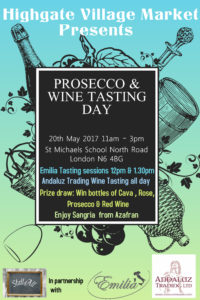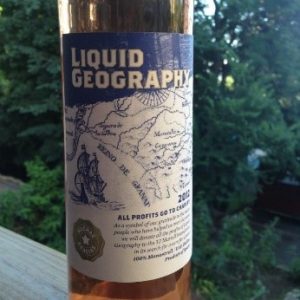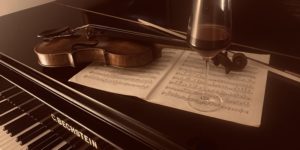ROBERT CUNNING – The City and Beyond
Highgate Gallery
16-29 September 2016
City, country and the boundary between
The City and Beyond considers the relationship between city and country and the boundary between urban and rural.
A common thread of Robert Cunning’s paintings is that they evoke a strong sense of place, whether it is the deep rural hills of South Shropshire and the Welsh Marches, or the inner cityscapes of London and New York. His paintings observe the changing architectural spaces of our cities and the seasonal changes of the countryside.
W G Sebald commented: “Places seems to me to have some kind of memory, in that they activate memory in those who look at them.”
The memory of place is key to some of the paintings. The impressive mountains and hills of Wales and the borderland contain ancient rock formations and fossils, giving clues to the history of earlier times. The river estuary of London was once covered in forest, the remnants of which are revealed by tides to this day.
Robert Cunning lived and taught in London for 20 years and now lives in rural Shropshire. The journey between the two places informs his work, for example, the entrance into London by rail at Euston and Kings Cross. This area, which used to be on the outskirts of the city, has been redeveloped considerably in recent times for the International ‘Eurostar’ at St Pancras.
His training as a gilder and frame-maker naturally inclined him towards the preparation of gesso for frames and panels. The smooth surface of the gesso allows the images to emerge with great clarity. The paintings are built up slowly with many layers of thin oil paint which are blended together while still wet.
www.robertcunning.co.uk
Tuesday-Friday 13:00-17:00
Saturday 11:00-16:00
Sunday 11:00-17:00
Closed Monday
ROBERT CUNNING – The City and Beyond
Highgate Gallery
16-29 September 2016
City, country and the boundary between
The City and Beyond considers the relationship between city and country and the boundary between urban and rural.
A common thread of Robert Cunning’s paintings is that they evoke a strong sense of place, whether it is the deep rural hills of South Shropshire and the Welsh Marches, or the inner cityscapes of London and New York. His paintings observe the changing architectural spaces of our cities and the seasonal changes of the countryside.
W G Sebald commented: “Places seems to me to have some kind of memory, in that they activate memory in those who look at them.”
The memory of place is key to some of the paintings. The impressive mountains and hills of Wales and the borderland contain ancient rock formations and fossils, giving clues to the history of earlier times. The river estuary of London was once covered in forest, the remnants of which are revealed by tides to this day.
Robert Cunning lived and taught in London for 20 years and now lives in rural Shropshire. The journey between the two places informs his work, for example, the entrance into London by rail at Euston and Kings Cross. This area, which used to be on the outskirts of the city, has been redeveloped considerably in recent times for the International ‘Eurostar’ at St Pancras.
His training as a gilder and frame-maker naturally inclined him towards the preparation of gesso for frames and panels. The smooth surface of the gesso allows the images to emerge with great clarity. The paintings are built up slowly with many layers of thin oil paint which are blended together while still wet.
www.robertcunning.co.uk
Tuesday-Friday 13:00-17:00
Saturday 11:00-16:00
Sunday 11:00-17:00
Closed Monday
ROBERT CUNNING – The City and Beyond
Highgate Gallery
16-29 September 2016
City, country and the boundary between
The City and Beyond considers the relationship between city and country and the boundary between urban and rural.
A common thread of Robert Cunning’s paintings is that they evoke a strong sense of place, whether it is the deep rural hills of South Shropshire and the Welsh Marches, or the inner cityscapes of London and New York. His paintings observe the changing architectural spaces of our cities and the seasonal changes of the countryside.
W G Sebald commented: “Places seems to me to have some kind of memory, in that they activate memory in those who look at them.”
The memory of place is key to some of the paintings. The impressive mountains and hills of Wales and the borderland contain ancient rock formations and fossils, giving clues to the history of earlier times. The river estuary of London was once covered in forest, the remnants of which are revealed by tides to this day.
Robert Cunning lived and taught in London for 20 years and now lives in rural Shropshire. The journey between the two places informs his work, for example, the entrance into London by rail at Euston and Kings Cross. This area, which used to be on the outskirts of the city, has been redeveloped considerably in recent times for the International ‘Eurostar’ at St Pancras.
His training as a gilder and frame-maker naturally inclined him towards the preparation of gesso for frames and panels. The smooth surface of the gesso allows the images to emerge with great clarity. The paintings are built up slowly with many layers of thin oil paint which are blended together while still wet.
www.robertcunning.co.uk
Tuesday-Friday 13:00-17:00
Saturday 11:00-16:00
Sunday 11:00-17:00
Closed Monday
ROBERT CUNNING – The City and Beyond
Highgate Gallery
16-29 September 2016
City, country and the boundary between
The City and Beyond considers the relationship between city and country and the boundary between urban and rural.
A common thread of Robert Cunning’s paintings is that they evoke a strong sense of place, whether it is the deep rural hills of South Shropshire and the Welsh Marches, or the inner cityscapes of London and New York. His paintings observe the changing architectural spaces of our cities and the seasonal changes of the countryside.
W G Sebald commented: “Places seems to me to have some kind of memory, in that they activate memory in those who look at them.”
The memory of place is key to some of the paintings. The impressive mountains and hills of Wales and the borderland contain ancient rock formations and fossils, giving clues to the history of earlier times. The river estuary of London was once covered in forest, the remnants of which are revealed by tides to this day.
Robert Cunning lived and taught in London for 20 years and now lives in rural Shropshire. The journey between the two places informs his work, for example, the entrance into London by rail at Euston and Kings Cross. This area, which used to be on the outskirts of the city, has been redeveloped considerably in recent times for the International ‘Eurostar’ at St Pancras.
His training as a gilder and frame-maker naturally inclined him towards the preparation of gesso for frames and panels. The smooth surface of the gesso allows the images to emerge with great clarity. The paintings are built up slowly with many layers of thin oil paint which are blended together while still wet.
www.robertcunning.co.uk
Tuesday-Friday 13:00-17:00
Saturday 11:00-16:00
Sunday 11:00-17:00
Closed Monday
ROBERT CUNNING – The City and Beyond
Highgate Gallery
16-29 September 2016
City, country and the boundary between
The City and Beyond considers the relationship between city and country and the boundary between urban and rural.
A common thread of Robert Cunning’s paintings is that they evoke a strong sense of place, whether it is the deep rural hills of South Shropshire and the Welsh Marches, or the inner cityscapes of London and New York. His paintings observe the changing architectural spaces of our cities and the seasonal changes of the countryside.
W G Sebald commented: “Places seems to me to have some kind of memory, in that they activate memory in those who look at them.”
The memory of place is key to some of the paintings. The impressive mountains and hills of Wales and the borderland contain ancient rock formations and fossils, giving clues to the history of earlier times. The river estuary of London was once covered in forest, the remnants of which are revealed by tides to this day.
Robert Cunning lived and taught in London for 20 years and now lives in rural Shropshire. The journey between the two places informs his work, for example, the entrance into London by rail at Euston and Kings Cross. This area, which used to be on the outskirts of the city, has been redeveloped considerably in recent times for the International ‘Eurostar’ at St Pancras.
His training as a gilder and frame-maker naturally inclined him towards the preparation of gesso for frames and panels. The smooth surface of the gesso allows the images to emerge with great clarity. The paintings are built up slowly with many layers of thin oil paint which are blended together while still wet.
www.robertcunning.co.uk
Tuesday-Friday 13:00-17:00
Saturday 11:00-16:00
Sunday 11:00-17:00
Closed Monday
ROBERT CUNNING – The City and Beyond
Highgate Gallery
16-29 September 2016
City, country and the boundary between
The City and Beyond considers the relationship between city and country and the boundary between urban and rural.
A common thread of Robert Cunning’s paintings is that they evoke a strong sense of place, whether it is the deep rural hills of South Shropshire and the Welsh Marches, or the inner cityscapes of London and New York. His paintings observe the changing architectural spaces of our cities and the seasonal changes of the countryside.
W G Sebald commented: “Places seems to me to have some kind of memory, in that they activate memory in those who look at them.”
The memory of place is key to some of the paintings. The impressive mountains and hills of Wales and the borderland contain ancient rock formations and fossils, giving clues to the history of earlier times. The river estuary of London was once covered in forest, the remnants of which are revealed by tides to this day.
Robert Cunning lived and taught in London for 20 years and now lives in rural Shropshire. The journey between the two places informs his work, for example, the entrance into London by rail at Euston and Kings Cross. This area, which used to be on the outskirts of the city, has been redeveloped considerably in recent times for the International ‘Eurostar’ at St Pancras.
His training as a gilder and frame-maker naturally inclined him towards the preparation of gesso for frames and panels. The smooth surface of the gesso allows the images to emerge with great clarity. The paintings are built up slowly with many layers of thin oil paint which are blended together while still wet.
www.robertcunning.co.uk
Tuesday-Friday 13:00-17:00
Saturday 11:00-16:00
Sunday 11:00-17:00
Closed Monday
ROBERT CUNNING – The City and Beyond
Highgate Gallery
16-29 September 2016
City, country and the boundary between
The City and Beyond considers the relationship between city and country and the boundary between urban and rural.
A common thread of Robert Cunning’s paintings is that they evoke a strong sense of place, whether it is the deep rural hills of South Shropshire and the Welsh Marches, or the inner cityscapes of London and New York. His paintings observe the changing architectural spaces of our cities and the seasonal changes of the countryside.
W G Sebald commented: “Places seems to me to have some kind of memory, in that they activate memory in those who look at them.”
The memory of place is key to some of the paintings. The impressive mountains and hills of Wales and the borderland contain ancient rock formations and fossils, giving clues to the history of earlier times. The river estuary of London was once covered in forest, the remnants of which are revealed by tides to this day.
Robert Cunning lived and taught in London for 20 years and now lives in rural Shropshire. The journey between the two places informs his work, for example, the entrance into London by rail at Euston and Kings Cross. This area, which used to be on the outskirts of the city, has been redeveloped considerably in recent times for the International ‘Eurostar’ at St Pancras.
His training as a gilder and frame-maker naturally inclined him towards the preparation of gesso for frames and panels. The smooth surface of the gesso allows the images to emerge with great clarity. The paintings are built up slowly with many layers of thin oil paint which are blended together while still wet.
www.robertcunning.co.uk
Tuesday-Friday 13:00-17:00
Saturday 11:00-16:00
Sunday 11:00-17:00
Closed Monday
ROBERT CUNNING – The City and Beyond
Highgate Gallery
16-29 September 2016
City, country and the boundary between
The City and Beyond considers the relationship between city and country and the boundary between urban and rural.
A common thread of Robert Cunning’s paintings is that they evoke a strong sense of place, whether it is the deep rural hills of South Shropshire and the Welsh Marches, or the inner cityscapes of London and New York. His paintings observe the changing architectural spaces of our cities and the seasonal changes of the countryside.
W G Sebald commented: “Places seems to me to have some kind of memory, in that they activate memory in those who look at them.”
The memory of place is key to some of the paintings. The impressive mountains and hills of Wales and the borderland contain ancient rock formations and fossils, giving clues to the history of earlier times. The river estuary of London was once covered in forest, the remnants of which are revealed by tides to this day.
Robert Cunning lived and taught in London for 20 years and now lives in rural Shropshire. The journey between the two places informs his work, for example, the entrance into London by rail at Euston and Kings Cross. This area, which used to be on the outskirts of the city, has been redeveloped considerably in recent times for the International ‘Eurostar’ at St Pancras.
His training as a gilder and frame-maker naturally inclined him towards the preparation of gesso for frames and panels. The smooth surface of the gesso allows the images to emerge with great clarity. The paintings are built up slowly with many layers of thin oil paint which are blended together while still wet.
www.robertcunning.co.uk
Tuesday-Friday 13:00-17:00
Saturday 11:00-16:00
Sunday 11:00-17:00
Closed Monday
ROBERT CUNNING – The City and Beyond
Highgate Gallery
16-29 September 2016
City, country and the boundary between
The City and Beyond considers the relationship between city and country and the boundary between urban and rural.
A common thread of Robert Cunning’s paintings is that they evoke a strong sense of place, whether it is the deep rural hills of South Shropshire and the Welsh Marches, or the inner cityscapes of London and New York. His paintings observe the changing architectural spaces of our cities and the seasonal changes of the countryside.
W G Sebald commented: “Places seems to me to have some kind of memory, in that they activate memory in those who look at them.”
The memory of place is key to some of the paintings. The impressive mountains and hills of Wales and the borderland contain ancient rock formations and fossils, giving clues to the history of earlier times. The river estuary of London was once covered in forest, the remnants of which are revealed by tides to this day.
Robert Cunning lived and taught in London for 20 years and now lives in rural Shropshire. The journey between the two places informs his work, for example, the entrance into London by rail at Euston and Kings Cross. This area, which used to be on the outskirts of the city, has been redeveloped considerably in recent times for the International ‘Eurostar’ at St Pancras.
His training as a gilder and frame-maker naturally inclined him towards the preparation of gesso for frames and panels. The smooth surface of the gesso allows the images to emerge with great clarity. The paintings are built up slowly with many layers of thin oil paint which are blended together while still wet.
www.robertcunning.co.uk
Tuesday-Friday 13:00-17:00
Saturday 11:00-16:00
Sunday 11:00-17:00
Closed Monday
ROBERT CUNNING – The City and Beyond
Highgate Gallery
16-29 September 2016
City, country and the boundary between
The City and Beyond considers the relationship between city and country and the boundary between urban and rural.
A common thread of Robert Cunning’s paintings is that they evoke a strong sense of place, whether it is the deep rural hills of South Shropshire and the Welsh Marches, or the inner cityscapes of London and New York. His paintings observe the changing architectural spaces of our cities and the seasonal changes of the countryside.
W G Sebald commented: “Places seems to me to have some kind of memory, in that they activate memory in those who look at them.”
The memory of place is key to some of the paintings. The impressive mountains and hills of Wales and the borderland contain ancient rock formations and fossils, giving clues to the history of earlier times. The river estuary of London was once covered in forest, the remnants of which are revealed by tides to this day.
Robert Cunning lived and taught in London for 20 years and now lives in rural Shropshire. The journey between the two places informs his work, for example, the entrance into London by rail at Euston and Kings Cross. This area, which used to be on the outskirts of the city, has been redeveloped considerably in recent times for the International ‘Eurostar’ at St Pancras.
His training as a gilder and frame-maker naturally inclined him towards the preparation of gesso for frames and panels. The smooth surface of the gesso allows the images to emerge with great clarity. The paintings are built up slowly with many layers of thin oil paint which are blended together while still wet.
www.robertcunning.co.uk
Tuesday-Friday 13:00-17:00
Saturday 11:00-16:00
Sunday 11:00-17:00
Closed Monday
ROBERT CUNNING – The City and Beyond
Highgate Gallery
16-29 September 2016
City, country and the boundary between
The City and Beyond considers the relationship between city and country and the boundary between urban and rural.
A common thread of Robert Cunning’s paintings is that they evoke a strong sense of place, whether it is the deep rural hills of South Shropshire and the Welsh Marches, or the inner cityscapes of London and New York. His paintings observe the changing architectural spaces of our cities and the seasonal changes of the countryside.
W G Sebald commented: “Places seems to me to have some kind of memory, in that they activate memory in those who look at them.”
The memory of place is key to some of the paintings. The impressive mountains and hills of Wales and the borderland contain ancient rock formations and fossils, giving clues to the history of earlier times. The river estuary of London was once covered in forest, the remnants of which are revealed by tides to this day.
Robert Cunning lived and taught in London for 20 years and now lives in rural Shropshire. The journey between the two places informs his work, for example, the entrance into London by rail at Euston and Kings Cross. This area, which used to be on the outskirts of the city, has been redeveloped considerably in recent times for the International ‘Eurostar’ at St Pancras.
His training as a gilder and frame-maker naturally inclined him towards the preparation of gesso for frames and panels. The smooth surface of the gesso allows the images to emerge with great clarity. The paintings are built up slowly with many layers of thin oil paint which are blended together while still wet.
www.robertcunning.co.uk
Tuesday-Friday 13:00-17:00
Saturday 11:00-16:00
Sunday 11:00-17:00
Closed Monday
ROBERT CUNNING – The City and Beyond
Highgate Gallery
16-29 September 2016
City, country and the boundary between
The City and Beyond considers the relationship between city and country and the boundary between urban and rural.
A common thread of Robert Cunning’s paintings is that they evoke a strong sense of place, whether it is the deep rural hills of South Shropshire and the Welsh Marches, or the inner cityscapes of London and New York. His paintings observe the changing architectural spaces of our cities and the seasonal changes of the countryside.
W G Sebald commented: “Places seems to me to have some kind of memory, in that they activate memory in those who look at them.”
The memory of place is key to some of the paintings. The impressive mountains and hills of Wales and the borderland contain ancient rock formations and fossils, giving clues to the history of earlier times. The river estuary of London was once covered in forest, the remnants of which are revealed by tides to this day.
Robert Cunning lived and taught in London for 20 years and now lives in rural Shropshire. The journey between the two places informs his work, for example, the entrance into London by rail at Euston and Kings Cross. This area, which used to be on the outskirts of the city, has been redeveloped considerably in recent times for the International ‘Eurostar’ at St Pancras.
His training as a gilder and frame-maker naturally inclined him towards the preparation of gesso for frames and panels. The smooth surface of the gesso allows the images to emerge with great clarity. The paintings are built up slowly with many layers of thin oil paint which are blended together while still wet.
www.robertcunning.co.uk
Tuesday-Friday 13:00-17:00
Saturday 11:00-16:00
Sunday 11:00-17:00
Closed Monday
Mondays @ the Mills: The geography of wine |
|||
| 3 July 2017
The geography of wine Phil Harrison, Highgate School Talks take place on Mondays at 7pm in the AV Room in the Mills Centre. Refreshments, including wine, are available from 6.30 pm and afterwards. |
|||
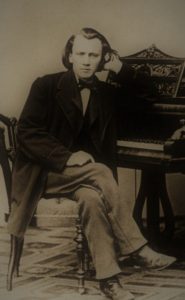
Serenata celebrate the music of Brahms this April at Lauderdale House.
This concert will feature an eclectic programme of Lieder, Duets & Piano Music by the Classical Romanticist, which will include the original scoring of the Love-Song Waltzes and a special arrangement of Wiegenlied, as well as the Gipsy Songs and selected Hungarian Dances.
Serenata will perform Aimez-vous Brahms? on Friday 27 April 2018 at 7:30pm.
Tickets are £12 (£8 concessions) and will be available on the door or from: 22 Chestnut Avenue N8 8NY (020 8348 2983).
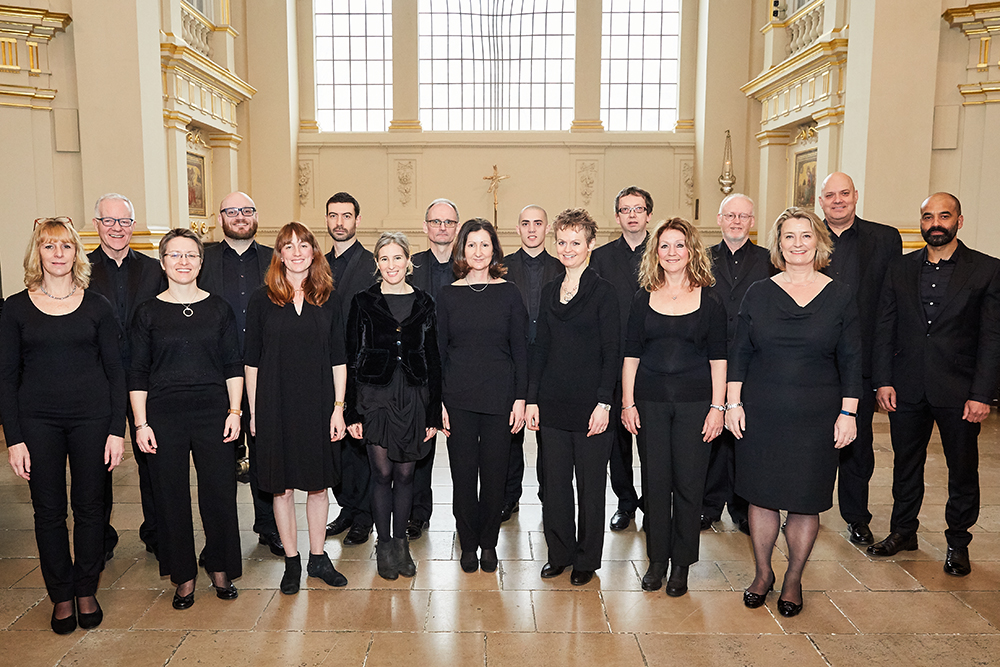 Brahms’ gorgeous, stirring Ein Deutsches Requiem is one of the great choral works, full of warm, rich harmonies. Inspired perhaps by the deaths of his mother, and his friend and fellow composer Robert Schumann, its music evokes comfort, loss, fear, peace and joy. Unlike other well known requiems, Brahms’ is not so much a mass for the dead as an offering of solace to those who mourn.
Brahms’ gorgeous, stirring Ein Deutsches Requiem is one of the great choral works, full of warm, rich harmonies. Inspired perhaps by the deaths of his mother, and his friend and fellow composer Robert Schumann, its music evokes comfort, loss, fear, peace and joy. Unlike other well known requiems, Brahms’ is not so much a mass for the dead as an offering of solace to those who mourn.
Jane Hopkins conducts Voxcetera, with soprano Ellie Sperling and baritone Jamie Sperling, using Iain Farrington’s acclaimed arrangement of the score for chamber ensemble. It promises to be both a grand and intimate experience.
There will be a bar open before and after the performance, and Voxcetera hopes you’ll stay to join us for wine and cake when the music finishes.
—
Voxcetera is a north London-based choir performing regularly in north and central London. Recent activity includes concerts at St Martin-in-the-fields, East Finchley Arts Festival, tours to southern Germany and recording work for Unicef’s Generations campaign. Its most recent Highgate concert was for Christmas 2018, in St Josephs RC Church.
In another little step back to the ethos of the London Novello Ensemble – which is the presentation of great music outside the formal constraints of the concert hall – Murray and Gavin present the two opposites of late 19th century romanticism along with music by Delius, Vitali and Sarasate, and a selection of popular tangos including Piazzolla’s famous ‘Libertango’
Gavin Davies studied the violin with Marta Eitler and at the Royal College of Music with Jaroslav Vanecek and Natasha Boyarsky. He combines a freelance orchestral career with ensembles such as the London Philharmonic and BBC Concert orchestras with regular chamber music and solo performances.
Murray Hipkin is a fulltime member of the music staff at English National Opera, where he has conducted The Mikado, The Gondoliers, The Pirates of Penzance, Kismet, Carousel, Chess and Man of la Mancha. He is musical director of the Pink Singers and the North London Chorus and he recently finished filming Anyone Can Sing for ENO/Sky Arts in the role of music supervisor and accompanist.
Programme to include:
Brahms – Sonata No. 1 in G
Liszt – Romance
Delius – Sonata No. 3
Vitali – Chaconne
Sarasate – Zigeunerweisen
Tangos by Albeniz, Gade, and Piazzolla
Advanced booking is advised as we will be limiting capacity in order to ensure socially distanced seating is available for those who require it. In accordance with normal practice, we respectfully ask that you do a lateral flow test – available free from www.gov.uk/order-coronavirus-lateral-flow-tests.com in the 48 hours prior to the concert – but please do get in touch for a full refund if you get a positive result!
This page is for the performance at Pond Square Chapel, Highgate on 9th December.
To buy tickets for the performance at St Paul’s Lorrimore Square, Kennington on 6th December, please click on this link: Brahms and Liszt in Kennington 6 December
